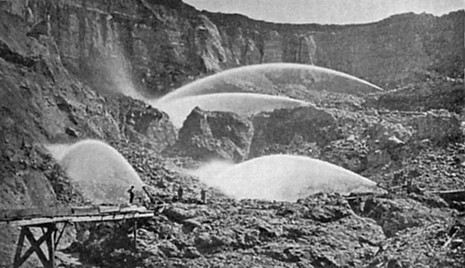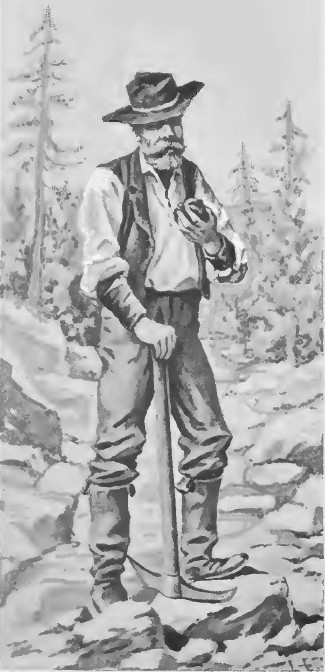The regular prospector, as
a rule, has at some time of his checkered career had some actual experience
in the mines themselves, from which he has learned by observation, the
appearance of different ores, their different values, how the veins appear
on the surface, how to open a vein, and the uses of pick, shovel, and
blasting powder. In a word he is a miner, who has become too restless to
stick to steady work, and so follows the more uncertain and precarious
livelihood of seeking for new and undiscovered veins, many of which even in
an old mining district may yet be discovered covered up by brush or debris,
whilst a new district offers a most enticing field. These mineral veins or
ledges, may make him in a moment a comparatively rich man, and if he finds
them, they will cost him nothing, only a simple compliance with the
inexpensive regulations of the law. So the life of a prospector offers many
attractions to one who is restless and loves to roam and loves to find
something new and is not afraid of considerable hardship. To save a vast
amount of time and labor, he should acquire knowledge.
Thus, for instance, if he were prospecting for coal he would be wasting his
time in hunting for it in granite, or if he was hunting for the precious
metals, he would lose time in looking for them among the unaltered
sedimentary strata of the prairie. This is merely for example, but an
infinite variety of knowledge is necessary for him in his vocation, besides
even that of the simpler elements of geology, such as the knowledge of
different kinds of minerals, and their value, the kind of places and
peculiar rocks they are associated with, their appearance on the surface,
etc., etc. together with some knowledge of assaying or blowpiping or
panning.
In a newly discovered camp, men will rush in for a few weeks, work a little in the different mines, sufficient to give them an idea of the kind of ores and rocks and other circumstances in the locality, and then will strike out on their own account and prospect around the camp for new veins or extensions of those already discovered. An extension, by the way, of a very rich discovered lode is not always to be relied on. Nature seems often to concentrate her riches at one point, and leave the extension barren, as in the case of the Comstock of Nevada. But little wealth has been found outside of the great lode and mine itself. The best education is in the mines themselves, so a novice on arriving at a mining region had better spend as much time as possible in practical work, in, and around the various mines, before he launches out prospecting. A prospector can rarely carry about much assaying or other apparatus with him for determining the character or value of ores he may find, and hence it is well for him to accustom himself to these ores in the mines themselves. Also he should acquaint himself with the peculiar ores of each particular district, before he attempts to prospect in its vicinity, for an ore such as coarse grained galena, in one district may be generally rich, whilst in another it is remarkably poor in silver.
The best previous education for a prospector would be a course at a school of mines, where he will learn the elements of geology, mineralogy, assaying, etc. And next to that, practical work in the mines themselves, and lastly the prospecting field. A little knowledge of blowpiping may also help him, which he may acquire at his school. Having left his school, he should learn the practical use of the pick, drill, and, blasting powder. By working around a concentrator he will learn the difference between ore and gangue rock; and "picking" or "sorting" ores, will teach him at sight the values of ores. The prospector should know how to open his vein or ledge, when he finds it, with pick, shovel, and blasting apparatus. A little carpentry will teach him how to make a hand winch, and a few lessons in blacksmithing, will teach him how to sharpen and temper his tools, for there will probably be no blacksmith's shop or carpenter's either, within miles of where he may go. Other prospectors will teach him how to use his pan or iron spoon for testing ores, and various other dodges and make-shifts. An important point is to learn how to average approximately the quantity of ore in, and value of, a ledge when he has found one. Valuable ore on a ledge lies in pockets, strings, bunches, irregularly distributed through the quartz or other material of the vein ; he should learn to tell at sight the relative proportion of ore and gangue. He would do well to study the result of working ores in a mill or furnace, such as trying to estimate the yield of bullion of the ores which are mind, taking them in weekly or monthly lots. With some such preliminary knowledge he is ready for the field.
We may divide the- prospecting for the precious metals into two general classes: hunting for gold in gold placers; hunting for gold and silver bearing ledges or veins or deposits. "Placers" are places where gold having been torn from the ledges and rocks by denudation, by water and ice, is swept down by these agencies till it finally finds a resting place. Gold being heavier than quartz or country rock, sinks to the bottom first. If the stream is violent, it will carry the gold on, if fine, till it comes to an eddy or pool, where the waters are more quiet, and there it will sink. The water carries the clay and lighter stones still further on. In this way millions of tons of rocks containing more or less gold disseminated through them may have been reduced, and the gold set free, or the gold may have been derived from a few individual gold bearing ledges or veins. The prospector takes his pick, shovel and pan, and his horn spoon, and finds perhaps an old dry river bed where the water has ages ago receded. At some point the sides of this old river course widen out suddenly, forming a basin. "Here," says the prospector, "there must have been an eddy," and he prospects it accordingly; at another point he finds a place where the water must have run over a rock, and made a waterfall; at the bottom he digs again.
He loosens the soil with his pick, and shovels it out; at a certain depth, which may be from 5 to 20 feet or more, he strikes "bed rock," which may be granite, shale, sandstone, or some other rock. Here he looks for nuggets, and with his knife digs into all the little crevices of the rock to hunt for them and for scales and wires of gold. Also whilst sinking his shaft, he pans the gravel carefully at various depths, especially where there are streaks of clay or " black sand." The latter are grains or little pebbles of magnetic iron ore, a common accompaniment of gold, altered relics of the iron pyrite in which the gold was originally contained. He fills his pan half full of water, throws into it a shovel full of dirt, first picking out the pebbles, stirs the mass with his fingers till the water is fully charged with the clay and gradually winnows out all the clay. Filling the pan again with water, he gives it a peculiar circular motion and each little wave of sand passes off till the whole is winnowed off, and at last he sees specks of gold shining free in the bottom of the pan. Then it is not difficult to estimate approximately the amount of gold to the bushel or cubic foot of earth of the placer, and thus to estimate the approximate value of the placer. He then locates or stakes out his placer claim according to the regulations of the U. S. Government, which, by a single individual cannot exceed twenty acres.
The second class of prospectors are those who try to discover ore deposits, ledges or veins, "in place," that is, in the hard rocks of the hills. The prospector's first effort is to find "float." A vein outcropping on the surface, becomes oxidized and crumbles by action of the atmosphere, rain, etc.; pieces break off and fall down hill. Some of this float is barren quartz or country rock, others may be mineralized. Commonly "float" is a rusty, spongy mass of rock, showing besides iron often some copper ore stains, and in it there may be grains of galena, pyrite or some other ore, He tries to trace this "float" to its home in the ledge whence it came. Of one thing he is certain, the float must have rolled down and not up hill. If the "float" is fairly scattered over the lower zone of the hill, and no "float" is found above that zone, on the top of that zone he will hunt for his ledge. If the "float" is all over the hill he assumes the ledge is on the top. If he finds his ' float" at the mouth of a canyon or water course, he walks up that water course, noticing not only the "float," and its diminishing or increase, but also any peculiar rocky pebbles, such as a peculiar porphyry, perhaps, which he may by chance recognize again further up in place, and give him a hint as to whence the stream derived most of its material of pebbles. He notices if the "float," fragments increase as he proceeds, and whether they suddenly cease at a certain point; at that point he hunts for the ledge on either side of the canyon, and breaks off any pieces that may look likely.
Having found the ledge and traced its croppings, he tries to find out its approximate value. This he does by breaking off at intervals along it likely looking fragments of the rock, grinding them up to about the size of peas. He mixes these well, and takes a half of them, reducing this to fine powder, and again halving it, till of the whole ledge he can carry away an averaged sample of a few ounces. He .may wash this in his pan to see if there is any free gold in it; other ores he will recognize at sight. These samples he will have assayed and the returns will show the approximate value. He measures the length and thickness of the vein, and examines the wall enclosing it. He then proceeds to locate or stake it out by measuring off a parallelogram 1,500 by 600 feet. At the corners of this, he places piles of stones, and in one or more of them places a stake of wood on which he writes his name, a description of his claim and the date. At the nearest recorder's office he files a copy of this document. He must do a certain amount of improvement work on this annually, such as digging a ten foot hole or putting up a cabin or some work equivalent to the value of $100, so as to hold it. He may also claim a mill site on non-mineral land adjacent not exceeding 5 acres. Now the property is his to do as he likes with it.
Continue on to:
Becoming A Prospector For Gold And Silver Ores, Part 2
Return To:
Gold And Silver Basic Prospecting Methods


